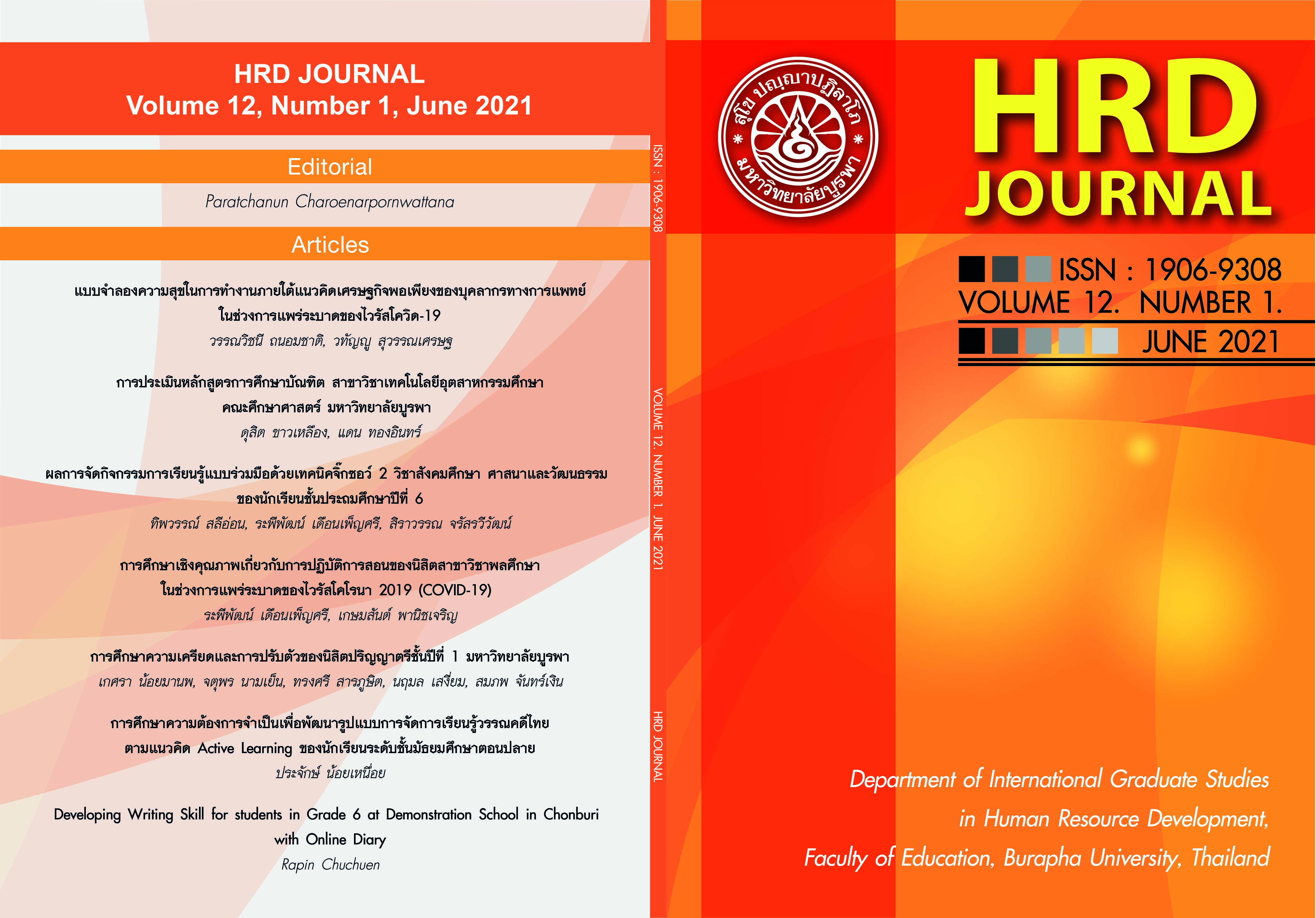The Results of Collaborative Learning Activities Using the Jigsaw 2 Technique in Social Studies, Religion and Culture of Prathomsuksa 6 Students
Keywords:
Jigsaw 2 Technique, Learning achievement, Collaborative ability, AttitudeAbstract
The purposes of this research were: 1) to compare learning achievement before and after studying Social Studies, Religion and Culture subject using the cooperative learning activity with jigsaw technique II of prathomsuksa 6 students, 2) to study the collaborative ability of prathomsuksa 6 students before and after studying by using the cooperative learning activity with jigsaw technique II, and 3) to study prathomsuksa 6 students’ attitudes towards cooperative learning with jigsaw techniques II. The sample was 35 students of prathomsuksa 6 students at Watsuwannaranyikawas School. The research instruments were: 1) six cooperative learning management with jigsaw techniques II lesson plans on “Good Citizens in Democracy”, 2) the learning achievement test consisting of 30 questions, 3) the collaborative ability evaluation test, 20 items, and 4) the attitudes towards the cooperative learning activity with jigsaw technique test, 10 items. Statistics used in data analysis were mean and standard deviation and t-test dependent. The research results were found as follows; 1. Learning achievement in Social Studies Religion and Culture subject of prathomsuksa 6 students who studying with the cooperative learning activity with jigsaw technique II was higher than before studying with statistical significance at the .05 level. 2. The collaborative ability of prathomsuksa 6 students after learning by using the cooperative learning activity using jigsaw technique II was at a good level with an average score of 2.15. 3. The attitudes towards cooperative learning using jigsaw technique II of prathomsuksa 6 students after learning by using the cooperative learning activity using jigsaw technique II was at the highest level.
References
กระทรวงศึกษาธิการ. (2553). แนวทางการจัดการเรียนรู้ตามหลักสูตรแกนกลางการศึกษาขั้นพื้นฐาน พุทธศักราช 2551. กรุงเทพฯ : โรงพิมพ์ชุมนุมสหกรณ์การเกษตรแห่งประเทศไทย จำกัด
ณภัค ช่วยแสง. (2556). การจัดกิจกรรมการเรียนรู้แบบร่วมมือเทคนิคจิ๊กซอว์และผังความคิด เรื่อง ภูมิศาสตร์ทวีปยุโรปและทวีปแอฟริกา กลุ่มสาระการเรียนรู้สังคมศึกษา ศาสนาและวัฒนธรรม ชั้นมัธยมศึกษาปีที่ 2. วิทยานิพนธ์ปริญญาครุศาสตร์มหาบัณฑิต, สาขาวิชาหลักสูตรและการเรียนการสอน, บัณฑิตวิทยาลัย, มหาวิทยาลัยราชภัฎมหาสารคาม
ทิศนา แขมมณี. (2555). ศาสตร์การสอน : องค์ความรู้เพื่อการจัดกระบวนการเรียนรู้ที่มีประสิทธิภาพ. กรุงเทพฯ : สำนักพิมพ์แห่งจุฬาลงกรณ์มหาวิทยาลัย
นาตยา ปิลันธนานนท์. และคณะ (2543). คู่มือการพัฒนาโรงเรียนเข้าสู่มาตรฐานการศึกษา การทำงานเป็นทีม (พิมพ์ครั้งที่ 2). กรุงเทพฯ : โรงพิมพ์การศาสนา
ประภาภรณ์ พลเยี่ยม. (2560). การพัฒนาทักษะการทำงานเป็นทีมโดยใช้การจัดการเรียนรู้แบบจิ๊กซอว์ 2 ร่วมกับสื่อสังคมออนไลน์ สำหรับนักเรียนชั้นมัธยมศึกษาปีที่ 5. วิทยานิพนธ์ปริญญาครุศาสตร์มหาบัณฑิต, สาขาวิชาคอมพิวเตอร์ศึกษา, มหาวิทยาลัยราชภัฏมหาสารคาม
ปริญญา ปั้นสุวรรณ์. (2553). การเปรียบเทียบผลสัมฤทธิ์การเรียนวรรณคดีไทยของนักเรียนชั้นมัธยมศึกษาปีที่ 2 ที่จัดการเรียนรู้แบบร่วมมือด้วยเทคนิคจิ๊กซอว์ 2 กับแบบปกติ. วิทยานิพนธ์ปริญญาศึกษาศาสตร์มหาบัณฑิต, สาขาวิชาการสอนภาษาไทย, บัณฑิตวิทยาลัย, มหาวิทยาลัยศิลปากร
พรพิมล พรพีรชนม์. (2550). การจัดกระบวนการเรียนรู้. สงขลา : เทมการพิมพ์สงขลา
ล้วน สายยศ และอังคณา สายยศ. (2538). เทคนิคการวิจัยทางการศึกษา. กรุงเทพฯ: สุวีริยาสาส์น
วิภาพรรณ พินลา และวิภาดา พินลา. (2561). การจัดการเรียนรู้สังคมศึกษาในยุคศตวรรษที่ 21. กรุงเทพฯ: สำนักพิมพ์แห่งจุฬาลงกรณ์มหาวิทยาลัย
วัฒนาพร ระงับทุกข์. (2541). การจัดการเรียนการสอนที่เน้นผู้เรียนเป็นศูนย์กลาง. กรุงเทพฯ: เลิฟแอนด์ลิพเพรส
สมใจ เพ็ชร์สุกใส. (2548). ผลการสอนวิชาวิทยาศาสตร์โดยใช้วิธีการเรียนแบบร่วมมือด้วยเทคนิคจิ๊กซอว์ II ที่มีต่อผลสัมฤทธิ์ทางการเรียนและความสามารถในการทำงานร่วมกันของนักเรียนชั้นมัธยมศึกษา ปีที่ 3. วิทยานิพนธ์ครุศาสตร์มหาบัณฑิต, สาขาหลักสูตรและการสอน, มหาวิทยาลัยราชภัฏนครสวรรค์
Johnson, D.W., & Johnson, R. T. (1994). Learning together and alone : cooperative, competitive, and individualistic learning. (4 th ed.). Boston : Allyn & Bacon
Slavin, R.E. (1995). Cooperative learning : theory, research, and practice (2 nd ed.). Boston: Allyn & Bacon
Downloads
Published
How to Cite
Issue
Section
License
Copyright@HRD Journal, Burapha University






